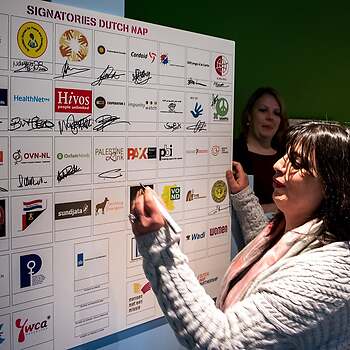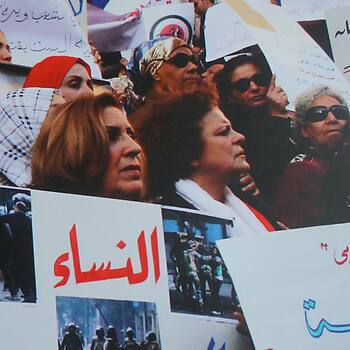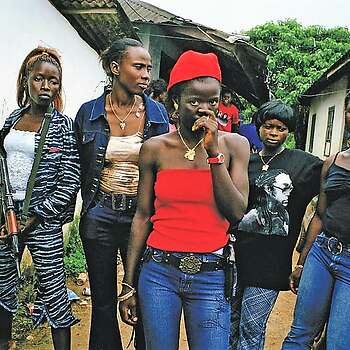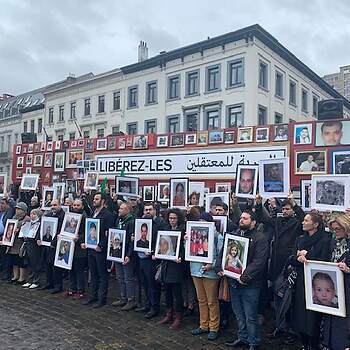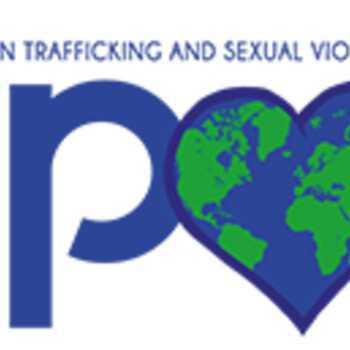The inspiration for the theme “Women, Peace and Security” rooted in different institutions and movements. For example, the feminist movements, the peace movements and the institutions and movements for human rights and human security. It was not easy to merge these different traditions and approaches in initiatives that would combine the strengths of all. In the policy document Women, Peace and Security grant instrument issued by the Ministry of Foreign Affairs, three meaningful results in situations of armed conflict were defined:
1. Significant decrease of Sexual and Gender Based Violence
2. Transformation of gender roles in postwar reconstruction and reconciliation
3. Participation of women in the peace and security sector
A theory was drafted by the NAP 1325 community, identifying together, based on experiments and research, which outcomes would contribute to these changes; and which well conducted activities would produce such outcomes. An interesting cross-cutting expertise was added to the considerations and practices: the knowledge on mental health, resilience and community self-help mechanisms.
It is still work in progress. In this chapter we mention a few key institutions, that share their concern from different perspectives on what is most relevant or effective. Together, they work on a common theory and practice for the implementation of the Security Council resolution 1325 and the subsequent resolutions against sexual and gender based violence.
1. Significant decrease in Sexual and Gender Based Violence
Documentation in the Netherlands can be found through the CRSV Network, established in 2018 to provide NGOs based in the Netherlands (NL) and working on conflict-related sexual violence (CRSV) the opportunity to get an insight on each other’s work and share knowledge on various issues related to sexual violence in conflict.
Search: https://impact-now.org/crsv-network-nl/
2. Transformation of Gender Roles
The most important documentation center on gender roles in the Netherlands is Atria. Atria, a knowledge institute for emancipation and women's history, stands for a gender-equal society, in which people receive as much equal treatment, equal rights and equal opportunities as possible. Atria collects and manages the heritage of women and women's movements. Atria also cooperates with WO=MEN and the Ministry of Foreign Affairs in documentation for the international meetings of CEDAW (the international convention on elimination of al forms of violence against women) and CWS (UN Committee on the Status of Women).
Search: https://collectie.atria.nl/
The Dutch Gender Platform WO=MEN hosts an online knowledge center, in which meaningful documents on gender and international cooperation is organized in chapters. The documents can be downloaded for free.
Search: https://www.wo-men.nl/kennisbank
A good source of information is also the publication of Vice Versa, a magazine on international cooperation, entitled “De wereld snakt naar vrouwelijke kracht”.
Search: https://viceversaonline.nl
3. Participation of Women in violence prevention and peace building
The perspective of security is mainly represented by special units of the Ministry of Defense and by organisations that defend women human rights defenders, such as Peace Brigades International and Protection International. The security perspective is important but still often ignored by women’s movements and policies. The reason to give it due attention is ideological but also practical.
On the ideological side, women feel limited and challenged by those who believe in lethal weapons as the main guarantee for security in our society. Their participation in peace building is heavily marginalized by this nationalistic ideology. The doctrine of “National Security” is however still the backbone of most defense policies and institutions, even when they promote stronger presence of women in the armed forces. The doctrine is severely questioned by organisations that develop policies on “Human Security”, defined as the need to protect human life and development. As noted in the UN General Assembly resolution 66/290, “human security is an approach to assist Member States in identifying and addressing widespread and cross-cutting challenges to the survival, livelihood and dignity of their people.” It calls for “people-centered, comprehensive, context-specific and prevention-oriented responses that strengthen the protection and empowerment of all people.” See https://www.un.org/humansecurity/what-is-human-security/
On the practical side, organisations like Peace Brigades International and Protection International support human rights defenders with elaborate nonviolent methods to guarantee their security. Within those organisations, studies have been made to draw attention to specific aspects of the security of women human rights defenders. Special manuals have been designed on various instruments to protect them. The Peace Brigades International study “Joint Initiative for Protection of Women Human Rights Defenders in the Arab World” mentions 3 dimensions that need continuous support, with awareness of gender differences.
- Systematic support to strengthen personal resilience against bullying, against social exclusion for being and activist; against threats to target the family; against sexual harassment (both from colleagues and opponents); and against loneliness during exile
- Adequate organizational precautions and procedures, such as not walking alone (non-violent body guards), not depending on a donor with gender prejudices, being prepared to close and reopen the office, avoiding unproductive confrontations, organize solidarity at all levels, seek protection from the law, security training, and, of course: cyber security – especially on names and addresses.
- Social analysis and broad communication and visibility strategies, building positive relationships with media and with influential people, streamlining positive messages, confidence building, reference to traditions and values cherished by religions.
